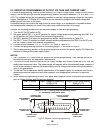83
-
5
15
-
0
00
Rev.
B
42
5.15 PARALLEL OPERATION
Up to four units of the same VOLTAGE and CURRENT rating can be connected in parallel to provide
up to four times the Output Current capability. One of the units operates as a Master and the remai
n-
ing
units are Slaves. The Slave units are analog programmed by the Master unit. In remote digital o
p-
eration, only the Master unit can be programmed by the computer, while the Slave units may be co
n-
nected to the computer for voltage, current and status readbac
k only. Follow the following procedure
to configure multiple supplies for parallel operation. Refer to Sec. 5.15
.1
and to Sec. 5.15.2 for d
e-
tailed explanation.
5.15.1
Basic parallel operation
In this method, setting the units as Master and Slaves is made by the r
ear panel J1 connections and
the setup switch SW1. Each unit displays its own output current and voltage. To program the load cu
r-
rent, the Master unit should be programmed to the total load current divided by the number of units in
the system. Refer to the
following procedure to configure multiple supplies for
basic
parallel operation.
1. Setting up the Master unit
Set the Master unit Output Voltage to the desired voltage. Program the Output Current to the d
e
sired
load current divided by the number of paral
lel units. During operation, the Master unit ope
r
ates in CV
mode, regulating the load voltage at the programmed Output Voltage. Connect the sensing circuit to
local or remote sensing as shown in Fig.5
-
4 or fig.5
-
5.
2.
Setting up the Slave units
-
1.
The Out
put Voltage of the Slave units should be programmed 2
-
5% higher than the Output
Voltage of the Master unit to prevent interference with the Master unit’s control. The Output Cu
r-
rent setting of each unit should be programmed to the desired load current div
ided by the number
of parallel units.
-
2. Set the rear panel setup switch SW1 position 2 to the up position.
-
3. Connect a wire jumper between J1
-
8 and J1
-
12 (refer to Table 4
-
4).
-
4. Connect J1 terminal 10(IPGM) of the slave unit to J1 terminal 25(P) of t
he master unit.
-
5. Connect J1 terminal 23(IPGM_RTN) of the slave unit to J1 terminal 12 (COM) of the master unit.
During operation, the Slave units operate as a controlled current source following the Master Ou
t
put
Current. It is recommended that the powe
r system be designed so that each unit supplies up to 95%
of its current rating because of the imbalance which may be caused by cabling and connection vol
t-
age drop.
3.
Daisy Chain Connection: (See Fig. 5.6)
These set up and connections are optional but is str
ongly recommended. It will shut down all
power supplies when a fault condition occurs in any one of them.
Switch SW1 position 5
s
hould be in its down position for all power supplies
.
Connect J1
-
16 of the Master Supply to J1
-
15 of the ‘First’
Slave Supply (
If any).
Connect J1
-
16 of the ‘First’ Slave Supply to J1
-
15 of the ‘Second’ Slave Supply (If any).
Connect J1
-
16 of the ‘Second’ Slave Supply to J1
-
15 of the ‘Third’ Slave Supply (If any).
Connect J1
-
16 of the ‘Last’ Slave Supply to J1
-
15 of the ‘Third’ Sl
ave Supply (If any).
Connect J1
-
2 (or J1
-
3) common to all supplies (See Fig. 5.6).
4.
Setting Over Voltage protection
The Master unit OVP setting should be programmed to the desired OVP level. The OVP setting of
the slave units should be programmed to a highe
r value than the Master OVP. When the Master
unit shuts down, it programs the Slave unit to zero Output Voltage. If a Slave unit shuts down
(when its OVP is set lower than the Master Output Voltage
and, if all P/S are not daisy chained
per section 3 above
)
, only that Slave unit would shut down, and the remaining Slave units would
supply all the load cu
r
rent.
5.
Setting Foldback protection
Foldback protection, is desired, may only be used with the Master unit. When the Master unit
shuts down, it programs the Sl
ave units to zero Output Vol
t
age.


















